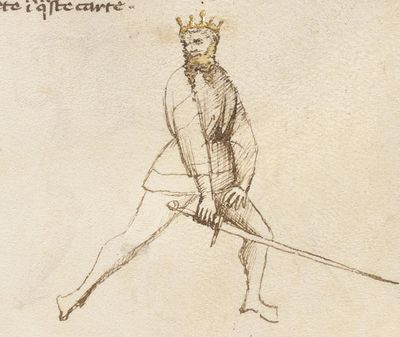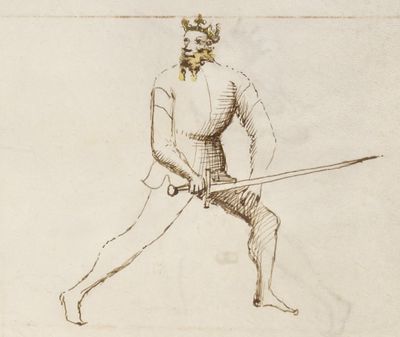But you just have to read the text, where the master is saying that he'll gimp himself by using the sword one handed. Or should we take it that he's saying "and even though I will use my sword one-handed which, oh well, is a give and take after all, it doesn't really change much"?
I don't think you're being very fair here. We agree he's gimping himself to make a point that these three are not good swordsman. Whether Fiore acknowledges the fact that he's gaining more reach or not, he is in fact gaining it. Why might they want to beat Fiore one handed? Because they too want bragging rights and they actually think they're capable. I'm saying "it doesn't change much" in regard to the fact he is still gimping himself.
You keep missing the point of the entire verbal exchange. Go and read the actual text, not crappy translations.
Sorry, I can't read middle Italian. The translation I own is Collin Hatcher's, since you didn't like it, I used Kendra Brown's, which you previously said was fine. If you want to link me to something better, I'll try to read it. It needs to be in my language though.
So now a "one handed archer's guard" is the best grip to throw a sword? Since we are giving so much weight to illustrations, there are specific illustrations in the two-handed section on sword throwing, and guess what, it's nothing like that.
Disagree. The two pictures look similar to me.
You are of course free to infer all you want, but you've already experienced yourself what the result can be.
I have no reason to believe the illustrations aren't reliable. They're of the period that Fiore lived, and they were vitally important to recreating his style in HEMA.
Ok, this is getting both bothersome and pointless, since you don't seem to be a learning animal.
Fist: the introduction to the section is a textbook rethorical device. Most likely it is not an episode from Fiore's life, most likely it is not inspired from a real happening, and so on. It is meant to be didascalic, and to provide the reader with a mental image of what is going to be taught. Why do you think the three guys announce that they will limit themselves to a different technique each? Do you really think that in real life they would give such an advantage to a dangerous master they are trying to win against? Not only the master is scary strong, now he even knows that he's getting first a thrust, then a slash, then a throw. Smart move, guys.
Likewise, the master is most likely not Fiore, but an abstraction. And what he says is not Fiore's thought on the three guys (who most likely never existed), it's a rethorical tool meant to show the reader that Fiore's one-hand guard is good against everything, period.
If you cannot even understand this, you'll keep drawing all the wrong conclusions.
Now, it's not that I don't like Collin Hatcher's translation. It's just shit. You are free to keep regarding it as the Rosetta Stone, and you'll keep drawing the incorrect conclusions, as you seem to be fond of doing with other shitty translations as well. You've been told about it several times with the greatest diplomacy possible, and instead of, you know, making a pause and maybe revising some (or all) of your assumptions, you keep doubling down. The very fact that you have no problem in taking whatsisname's claim of having spent 17 years on the subject as a guarantee of competence is extremely telling.
It's not the same grip, since the image you linked is a two handed technique. Sorry, if applies to gripping close to the pommel it also applies here: once again, you can't have it both ways. And there are more illustration with throwing with the fingers around the crossguard: this alone should make you think about taking the illustrations as the deciding factor. And here we come to the point: by far the most charitable interpretation of the illustrator's choices is that he is excessively aware of the fact that this is the one-hand section, and therefore he feels compelled to draw everybody, and not just the maestro/the one performing the technique, with a one-hand grip, even when it doesn't make sense.
You seem to have no idea of all the issues related to the transmission of manuscripts, and how flimsy 'evidence' for their dating typically is; how copyright worked back then (hint: it didn't), how each copy carried a heavy risk of being interpolated, distorted, 'helpfully integrated' or bastardized; of all the cans of worms related to writing directly vs dictating vs giving instructions to write, etc. etc. And that's nothing compared to the problems that illustrations usually raise: if they are added afterwards, if they are from multiple illustrators, if the illustrators receive instructions from the author or simply try to interpret the text by themselves; not to speak about how with each copy, since photocopying wasn't a think yet, illustrations were modified, misunderstood, reinterpreted, 'corrected', 'updated' according to currend trends in armour and weapons (but a lot the times only 'updating' some elements and leaving others untouched, which makes it even more of a mess), and so on, and so on, and so on.
Of course you have no reason to think that the illustrations are not reliable: you are blissfully unencumbered by any of the aforementioned issues.
Finally, I don't give a rats' ass if HEMA 'scholars' share this approach of yours, though I doubt it: the few that I've seen tend to have many more doubts and ask themselves many more questions than you do. Oh, and they seem willing to learn.















